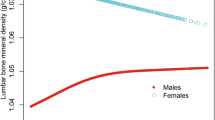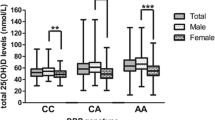Abstract
To test whether in Moroccan healthy postmenopausal women, levels of plasma total homocysteine (tHcy), folate, and vitamin B12 are related to BMD. A total of 188 volunteer postmenopausal women were recruited from our blood taking center between April 2008 and December 2008. Each subject completed a standardized questionnaire designed to document putative risk factors of osteoporosis. Bone mineral density was determined by a Lunar Prodigy Vision DXA system, and blood samples for plasma tHcy, folate, vitamin B12, and serum parathyroid hormone (PTH) were taken. Comparison between women with osteoporosis, osteopenia and normal BMD showed that the osteoporotic women were significantly older, had lower weight and height than the women of the other groups. Plasma tHcy was significantly higher in the osteoporotic group. Levels of tHcy were inversely related to BMD at the lumbar spine, at the total hip and plasma vitamin B12 and positively related to age and creatinine. Multiple regression analysis showed that age and BMI were the main predictors of BMD at the lumbar spine, whereas the main predictors of BMD at the total hip were age, BMI, plasma tHcy, and plasma vitamin B12. tHcy and vitamin B12 are independent risk factors for osteoporosis in Moroccan healthy postmenopausal women.
Similar content being viewed by others
References
Trabetti E (2008) Homocysteine, MTHFR gene polymorphisms, and cardio-cerebrovascular risk. J Appl Genet 49:267–282
Ravaglia G, Forti P, Maioli F et al (2005) Homocysteine and folate as risk factors for dementia and Alzheimer disease. Am J Clin Nutr 82:636–643
McLean RR, Jacques PF, Selhub J et al (2008) Plasma B vitamins, homocysteine, and their relation with bone loss and hip fracture in elderly men and women. J Clin Endocrinol Metab 93:2206–2212
Rhew EY, Lee C, Eksarko P et al (2008) Homocysteine, bone mineral density, and fracture risk over 2 years of followup in women with and without systemic lupus erythematosus. J Rheumatol 35:230–236
McLean RR, Hannan MT (2007) B vitamins, homocysteine, and bone disease: epidemiology and pathophysiology. Curr Osteoporos Rep 5:112–119
Bhupathiraju SN, Alekel DL, Stewart JW et al (2007) Relationship of circulating total homocysteine and C-reactive protein to trabecular bone in postmenopausal women. J Clin Densitom 10:395–403
Perez-Castrillon JL, Arranz-Pena ML, Luis DD (2004) Homocysteine as a predictive factor for hip fracture in older persons. N Engl J Med 351:1027–1030 (author reply -30)
Lucock MD, Daskalakis IG, Wild J et al (1996) The influence of dietary folate and methionine on the metabolic disposition of endotoxic homocysteine. Biochem Mol Med 59:104–111
Vaes BL, Lute C, Blom HJ et al (2009) Vitamin B(12) deficiency stimulates osteoclastogenesis via increased homocysteine and methylmalonic acid. Calcif Tissue Int 84:413–422
Morris MS, Jacques PF, Selhub J (2005) Relation between homocysteine and B-vitamin status indicators and bone mineral density in older Americans. Bone 37:234–242
Blouin S, Thaler HW, Korninger C et al (2009) Bone matrix quality and plasma homocysteine levels. Bone 44:959–964
Khan M, Yamauchi M, Srisawasdi S et al (2001) Homocysteine decreases chondrocyte-mediated matrix mineralization in differentiating chick limb-bud mesenchymal cell micro-mass cultures. Bone 28:387–398
Herrmann M, Widmann T, Herrmann W (2006) Re: “elevated serum homocysteine and McKusick’s hypothesis of a disturbed collagen cross-linking: what do we really know?” Bone 39:1385–1386 (author reply 6–7)
Knott L, Bailey AJ (1998) Collagen cross-links in mineralizing tissues: a review of their chemistry, function, and clinical relevance. Bone 22:181–187
Herrmann M, Widmann T, Herrmann W (2005) Homocysteine–a newly recognised risk factor for osteoporosis. Clin Chem Lab Med 43:1111–1117
El Maghraoui A, Koumba BA, Jroundi I, Achemlal L, Bezza A, Tazi MA (2005) Epidemiology of hip fractures in 2002 in Rabat, Morocco. Osteoporos Int 16:597–602
El Maghraoui A, Guerboub AA, Achemlal L et al (2006) Bone mineral density of the spine and femur in healthy Moroccan women. J Clin Densitom 9:454–460
El Maghraoui A, Guerboub AA, Mounach A et al (2007) Body mass index and gynecological factors as determinants of bone mass in healthy Moroccan women. Maturitas 56:375–382
El Maghraoui A, Morjane F, Nouijai A, Achemlal L, Bezza A, Ghozlani I (2009) Vertebral fracture assessment in Moroccan women: prevalence and risk factors. Maturitas 62:171–175
El Maghraoui A, Ghazi M, Gassim S et al (2009) Bone mineral density of the spine and femur in a group of healthy Moroccan men. Bone 44:965–969
El Maghraoui A, Do Santos Zounon AA, Jroundi I et al (2005) Reproducibility of bone mineral density measurements using dual X-ray absorptiometry in daily clinical practice. Osteoporos Int 16:1742–1748
van Meurs JB, Dhonukshe-Rutten RA, Pluijm SM et al (2004) Homocysteine levels and the risk of osteoporotic fracture. N Engl J Med 350:2033–2041
Cagnacci A, Baldassari F, Rivolta G, Arangino S, Volpe A (2003) Relation of homocysteine, folate, and vitamin B12 to bone mineral density of postmenopausal women. Bone 33:956–959
Golbahar J, Hamidi A, Aminzadeh MA, Omrani GR (2004) Association of plasma folate, plasma total homocysteine, but not methylenetetrahydrofolate reductase C667T polymorphism, with bone mineral density in postmenopausal Iranian women: a cross-sectional study. Bone 35:760–765
Mudd SH, Skovby F, Levy HL et al (1985) The natural history of homocystinuria due to cystathionine beta-synthase deficiency. Am J Hum Genet 37:1–31
McLean RR, Karasik D, Selhub J et al (2004) Association of a common polymorphism in the methylenetetrahydrofolate reductase (MTHFR) gene with bone phenotypes depends on plasma folate status. J Bone Miner Res 19:410–418
Liu G, Nellaiappan K, Kagan HM (1997) Irreversible inhibition of lysyl oxidase by homocysteine thiolactone and its selenium and oxygen analogues. Implications for homocystinuria. J Biol Chem 272:32370–32377
Chwatko G, Jakubowski H (2005) The determination of homocysteine-thiolactone in human plasma. Anal Biochem 337:271–277
Herrmann M, Kraenzlin M, Pape G, Sand-Hill M, Herrmann W (2005) Relation between homocysteine and biochemical bone turnover markers and bone mineral density in peri- and post-menopausal women. Clin Chem Lab Med 43:1118–1123
Dhonukshe-Rutten RA, Lips M, de Jong N et al (2003) Vitamin B-12 status is associated with bone mineral content and bone mineral density in frail elderly women but not in men. J Nutr 133:801–807
Tucker KL, Hannan MT, Qiao N et al (2005) Low plasma vitamin B12 is associated with lower BMD: the Framingham Osteoporosis Study. J Bone Miner Res 20:152–158
Stone KL, Bauer DC, Sellmeyer D, Cummings SR (2004) Low serum vitamin B-12 levels are associated with increased hip bone loss in older women: a prospective study. J Clin Endocrinol Metab 89:1217–1221
Macdonald HM, McGuigan FE, Fraser WD, New SA, Ralston SH, Reid DM (2004) Methylenetetrahydrofolate reductase polymorphism interacts with riboflavin intake to influence bone mineral density. Bone 35:957–964
Acknowledgments
This study was funded by AMIRHAL: the “Association Marocaine de Recherche et d’Information sur l’handicap et l’Appareil Locomoteur”.
Conflict of interest
None.
Author information
Authors and Affiliations
Corresponding author
Rights and permissions
About this article
Cite this article
Ouzzif, Z., Oumghar, K., Sbai, K. et al. Relation of plasma total homocysteine, folate and vitamin B12 levels to bone mineral density in Moroccan healthy postmenopausal women. Rheumatol Int 32, 123–128 (2012). https://doi.org/10.1007/s00296-010-1551-x
Received:
Accepted:
Published:
Issue Date:
DOI: https://doi.org/10.1007/s00296-010-1551-x




